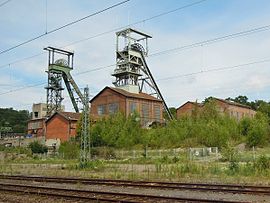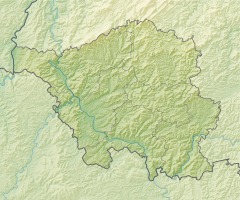Luisenthal mine
| Luisenthal mine | |||
|---|---|---|---|
| General information about the mine | |||
| View from the train station | |||
| other names | Gerhard Pit | ||
| Mining technology | Civil engineering | ||
| Funding / total | 58,000,000 t of hard coal | ||
| Information about the mining company | |||
| Start of operation | 1820 | ||
| End of operation | 2005 | ||
| Funded raw materials | |||
| Degradation of | Hard coal | ||
| Geographical location | |||
| Coordinates | 49 ° 15 '2 " N , 6 ° 54' 18" E | ||
|
|||
| Location | Luisenthal | ||
| local community | Völklingen | ||
| country | State of Saarland | ||
| Country | Germany | ||
The pit Luisenthal was a coal mine in Voelklinger district Luisenthal , which in 1820 began operations and coal production on 17 June 2005 was established. The mine became known for the worst mining accident in the history of the Federal Republic of Germany , in which 299 miners died on February 7, 1962 .
history
Mining of coal seams emerging in the area of today's Luisenthal is first documented for the year 1731. In 1820 the Prussian Mountain Treasury merged the Bauernwald and Großwald pits to form the Bauernwald-Großwald mine , which was named "Grube Gerhard" in the following year after the then chief miner Johann Carl Ludewig Gerhard . In order to be able to transport coal to the Saar , the Veltheim tunnel was dug in 1837 . The 3705 meter long tunnel later led to the Viktoria mine in Püttlingen; the mouth hole is not far from the Luisenthal mine. The first shaft at the current location of the pit was the 1,862 wells drilled Albert slot. It was located directly on the railway line from Saarbrücken to Merzig , which opened in 1858, which improved the sales opportunities for coal.
At the end of the 19th century, the previously mined coal fields north of the Saar were exhausted. Boreholes in 1897 and 1898 showed that there were 500 to 600 meters thick coal mountains on both sides of the Saar. To develop it, Richardschacht I, a production shaft at the location of the Albert shaft, and the Delbrückschacht, a weather shaft on the left bank of the Saar near Klarenthal , were sunk from 1899 onwards . In 1903, levels were driven at depths of 600 and 666 meters . In education and Vorrichtearbeiten it came in 1904 to a coal fire , so that the pit for three months under water was. From 1910 on, a further weather shaft was sunk south of the Saar with the east shaft at Ottenhausen (later renamed Calmelet shaft). The Richard II shaft, which was struck in 1912, was intended to be used for extraction from the bottom at a depth of 830 meters in the northern section of the mine.
In October 1914, after another pit fire, the entire mine was flooded. After several failed attempts, the mine was partially swamped under French administration in 1923 . The part below the 600 meter level remained under water, as it was apparently still burning there. As a result of further mine fires and the difficult economic situation, it took until 1935 before regular production could be started. In 1938 the Richardschacht II was sunk further. During the Second World War , the mine was shut down between December 1944 and May 1945, both at the beginning and at the end of the war. 31 people died in a mine accident on July 16, 1941.
In 1954, a mine gas extraction system was installed because problems with gas outbreaks persisted. The mine gas extracted is fed to the Fenne power station . In 1954 the sinking of the Alsbach shaft in the Saarbrücken district of Burbach began after test drilling had proven large coal deposits. In 1957 a conveyor tunnel was built through which the newly built Fürstenhausen coking plant was supplied with coal.
Luisenthal mine disaster in 1962
On February 7, 1962 at 7:50 a.m., one of the most serious mining accidents in German history occurred in the Luisenthal mine. An explosion in Alsbachfeld killed 299 miners. Most likely, they went from one parent and under eaves crosscut of which was only weakly bewettert and in the hanging wall to methane gas had accumulated. Starting as a mine gas flaming, which triggered a firedamp explosion in the area of a road junction , there were finally a series of coal dust explosions with devastating effects. The explosion could have such a devastating effect despite numerous rock dust barriers and wet areas. The cause of the ignition remained unclear. The lighting of a cigarette (smoking material was found) or the filament of a damaged headlamp are most likely to be considered.
At that time there were 664 workers underground, 433 of them in the explosion area. Only 61 remained unharmed. Today a memorial with a statue of St. Barbara and three arched windows by the artist Ferdinand Selgrad in the building of the Saarbrücken mine management building from 1964 commemorates the accident. In the German coal mining industry , the dust-binding method and the use of water trough barriers were introduced as a result of this mine accident .
After 1962
In 1966, the Luisenthal mine took over the fields of the closed Viktoria mine in Püttlingen and the Amelung field of the Von der Heydt mine . Between 1965 and 1967 the 5.5 kilometer long Ludwigsstollen was excavated as a composite tunnel to the Jägersfreude mine. In the 1970s, Luisenthal formed a composite mine together with the Camphausen mine ; in the 1990s it was the Warndt to mine Warndt / Luisenthal merged. An underground network was established in 1995.
Coal production at the Luisenthal site was discontinued at the end of 1994, but the shafts were still used for transporting material and for ropes . In mid-2005, the Warndt / Luisenthal mine finally stopped coal production. In 2006 the Warndt shaft was filled with concrete . The Richardschächte in Luisenthal were kept open for a while for the extraction of mine gas . By June 2012, both Richard shafts had been filled to a depth of 97 meters . Mine gas will continue to be sucked in, the dewatering is now in the well operation.
In the time of its existence, a total of around 58 million tons of coal were mined. In 1959, about 3800 miners were employed in Luisenthal. The workforce almost halved between 1958 and 1994, while underground output (coal production per man shift) nearly quadrupled.
After the end of the Saar mining industry, the ravages of time also left their mark on the grounds of the Luisenthal mine. On November 19, 2018, the demolition of the buildings on the site began. Only listed buildings, such as B. the headframes or the administration building are retained.
Luisenthal mining dump
To the west of the actual mine is an approx. 50 meter high mine dump that was in operation until the end of coal production on June 17, 2005. It is open to the public and has been a nature reserve since it was recultivated . In the future, RAG is planning to install wind turbines and a solar system on the dump to generate energy and use space in closed mines and dumps.
literature
- Paul Burghard u. a. (Ed.): Luisenthal in February. Chronicle of a mining disaster . SDV, Saarbrücken 2012
- Delf Slotta, RAG Aktiengesellschaft (Herne) (Hrsg.), Institut für Landeskunde im Saarland eV (Schiffweiler) (Hrsg.): Der Saarländische Steinkohlenbergbau , Krüger Druck und Verlag GmbH & Co. KG, Dillingen / Saar 2011, ISBN 978-3 -00-035206-5
- Literature on Grube Luisenthal in the Saarland Bibliography
Web links
- Gerhild Krebs: Luisenthal mine near Memotransfront - sites of cross-border memory.
- Völklingen in transition: the Luisenthal mine
- Christoph Gunkel: Luisenthal pit disaster - Hell of fire at a depth of 600 meters. In: einestages.spiegel.de. February 6, 2016, accessed February 6, 2016 .
Individual evidence
- ↑ For the history of the Luisenthal mine, see Rainer Slotta : Förderturm und Bergmannshaus. From mining on the Saar. (= Publications from the German Mining Museum Bochum , 17), Saarbrücker Druckerei und Verlag, Saarbrücken 1979, ISBN 3-921646-18-9 , p. 112ff.
- ^ Evelyn Kroker , Michael Farrenkopf: Mine accidents in German-speaking countries. Catalog of the mines, victims, causes and sources. (= Publications from the Deutsches Bergbau-Museum Bochum , No. 79) Deutsches Bergbau-Museum, Bochum 1999, ISBN 3-921533-68-6 , p. 423.
- ↑ Standing committee for operational safety and health protection in hard coal mining (ed.): Flammable dusts. Luxembourg 1968.
- ^ CH Fritzsche, H. Schulze-Rhonhof: The explosion accident on the Luisenthal mine. Glückauf 101 (1965), No. 1, pp. 23-33. (With pit plan of the Alsbach field)
- ↑ Our dead miners , accessed on January 24, 2014
- ↑ Walter Hermülheim: Pit safety assessment of hard coal mines in emerging countries. In: Hossein H. Tudeshi (Ed.) AMS Online GmbH: Advanced Mining Solutions. 2011, No. 3, p. 25.
- ↑ Volker Fuchs: Dug into the depths with a pick and shovel. Grube Luisenthal is 100 years old this year. ( Page no longer available , search in web archives ) Info: The link was automatically marked as defective. Please check the link according to the instructions and then remove this notice. In: Saarbrücker Zeitung . February 23, 1999.
- ^ Farewell to the Luisenthal mine. In: Saarbrücker Zeitung. July 3, 2006.
- ↑ Extreme civil engineering: aaton fills mine shafts ( page can no longer be accessed , search in web archives ) Info: The link was automatically marked as defective. Please check the link according to the instructions and then remove this notice. , Press release on the website of Cemex AG, seen July 7, 2012
- ↑ Focus today: Luisenthal mine. In: Saarbrücker Zeitung. August 26, 1995.

